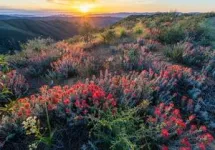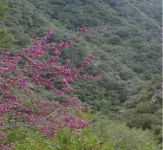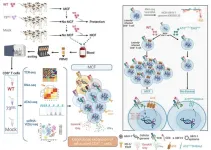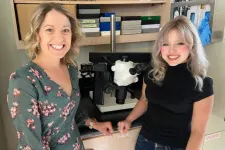(Press-News.org) From coastal redwoods and Joshua trees to golden poppies and sagebrush, California is a global botanical hotspot. It’s also a place confronted with extreme heat, wildfires and crumbling coastlines. The state’s natural beauty and history of pioneering conservation efforts make it a test bed for protecting biodiversity in the face of current and future climate change, argues a study led by the University of California, Davis.
Published July 29 in Proceedings of the National Academy of Sciences, the study, “Climate Change and California’s Terrestrial Biodiversity,” is part of a special PNAS issue on California sustainability. The study concludes that California’s 30 x 30 Initiative to preserve 30% of its lands and coastal waters by 2030, along with efforts to harmonize biodiversity conservation and renewable energy, is a promising step. It also highlights the need for California to shift away from its decades-long fire suppression policies and adopt fire strategies reflective of new fire regimes.
“California has had a history for over 100 years of being a leader in protecting the environment — from setting aside parks for people to climate adaptation,” said lead author Susan Harrison, a professor in the UC Davis Department of Environmental Science and Policy. “The threats are extreme and unprecedented, but California has always been a state where creative new solutions have emerged.”
California’s climate has become warmer, drier and more variable since the mid-1900s, the study noted. It examined major threats climate change poses to the state’s biodiversity and sustainability. These include the impacts of shifting plant biodiversity, land-use change, wildfire and renewable energy, and the policy responses to those challenges.
Hot spots on the move
The authors modeled the distribution of about 6,400 native plant species, identifying 15 regional plant biodiversity hot spots — from small areas, such as the Channel Islands, to vast parts of the Sierra Nevada and coastal ranges.
The models indicate these hot spots could lose an average of 19% of their native plant species by 2080 under current climate projections. California’s complex mosaic of microclimates means the state’s species could respond in a wide variety of ways to climate change. Some hot spots are expected to move toward the coast or upslope, while others remain or disappear.
Those stakes help outline the need for renewable energy projects to align with expected biodiversity shifts and needs. For example, Molok Luyuk, or Condor Ridge (formerly Walker Ridge), was slated for wind development projects along its blustery ridge despite its rich biodiversity before earning protection as part of Berryessa Snow Mountain National Monument.
“This paper is pointing out that we need to be proactive,” said co-author James H. Thorne, a research scientist with the UC Davis Environmental Science and Policy department. “We can’t be reactive like, ‘Oh, this wildfire is out of control. Oh, this species is disappearing. Oh, we misplaced where this green energy site should go.’ We have tools that can be used, some of which we discuss in this paper.”
A new mindset
Wildfire is a nearly year-round reminder of the state’s hotter, drier climate.
The authors write that fire management policies in California are less progressive than its policies for climate and conservation. The paper encourages the state to move away from its longstanding policy of fire suppression and adapt its strategies to use fire as an ecosystem management tool. State and federal agencies have set ambitious targets to increase the use of fire in land management but have been stymied by bans on prescribed fire motivated by safety and air quality concerns.
Harrison calls wildfire and climate change “game-changers” for how we think about conservation.
“Traditionally, ‘conservation’ had a restrictive meaning—we try to keep things the same. If anything goes missing, we try to put it back,” Harrison said. “But now, we require a different mindset. We need to be willing to modify traditional views of conservation. We need continual innovation.”
Additional co-authors include Rebecca R. Hernandez and Hugh Safford of UC Davis, Janet Franklin of San Diego State University, and Makihiko Ikegami of National Institute of Environmental Studies - Shiga, Japan.
END
California a botanical and climate change hot spot
Combination marks opportunities for climate adaptation and innovation
2024-07-29
ELSE PRESS RELEASES FROM THIS DATE:
Young scientists face career hurdles in interdisciplinary research
2024-07-29
COLUMBUS, Ohio – Scientists agree that solving some of society’s greatest challenges in biomedicine such as food sustainability, aging and disease treatment will need researchers from a variety of scientific fields working together.
But a new study finds that the young scientists who most embrace interdisciplinary research face “career impediments” not seen in their peers who focus their work only within their own disciplines.
The results are troublesome and pose a “grave challenge” to efforts to increase interdisciplinary ...
New progress in research into malignant catarrhal fever in cattle
2024-07-29
A research team led by University of Liège scientists has published a groundbreaking study on malignant catarrhal fever (MCF). This disease is caused by the alcelaphine gammaherpesvirus 1 (AlHV-1), which infects its natural host, the wildebeest. This study sheds light on the mechanisms by which this virus, which is asymptomatic and latent in the wildebeest, causes an oligoclonal expansion of CD8+ T lymphocytes in cattle, leading to the development of MCF.
In 2013, the research team had already demonstrated (1) that malignant catarrhal fever (MCF), which is fatal in cattle, only develops if the AlHV-1 virus can maintain a ...
Words like ‘this’ and ‘that’ act as attention tools across languages
2024-07-29
All languages have words like ‘this’ and ‘that’ to distinguish between referents that are ‘near’ and ‘far’. Languages like English or Hebrew have two of these ‘demonstratives’. Languages like Spanish or Japanese use a three-word system. For instance, in Spanish, ‘este’ signals something close to the speaker, ‘ese’ signals something far from the speaker but close to the listener, and ‘aquel’ signals something far from both.
“The reason why we were interested in demonstratives is because of their ...
Local food production saves costs and carbon
2024-07-29
Local foods are critical to the food security and health of Indigenous peoples around the world, but local "informal" economies are often invisible in official economic statistics. Consequently, these economies may be overlooked in the policies designed to combat climate change. For instance, Indigenous communities in the North American Arctic are characterized by mixed economies featuring hunting, fishing, gathering and trapping activities, alongside the formal wage economy. The region is also undergoing a rapid transformation due to social, economic and climatic changes. In Canada, the introduction ...
Bold moves needed for California agriculture to adapt to climate change
2024-07-29
California should take urgent and bold measures to adapt its $59 billion agriculture sector to climate change as the amount of water available for crops declines, according to a collaborative report by University of California faculty from four campuses.
Published in the Proceedings of the National Academy of Sciences, the report provides a roadmap for more water capture, storage, and distribution systems that are in harmony with climate projections and ecosystems. It further considers how runoff and groundwater can be used repeatedly ...
To get drivers to put down their phones, make it a game
2024-07-29
If you’re trying to keep drivers from picking up their phones, make it a game, according to a new Proceedings of the National Academy of Sciences (PNAS) study led by researchers from the Perelman School of Medicine at the University of Pennsylvania. When drivers could earn points for making reductions in handheld phone use and had the chance to compete in a weekly leaderboard of others like them, researchers saw as much as a 28 percent reduction in handheld phone use while driving, a habit that stuck once the intervention—and the games—ended.
“Distracted driving ...
Study identifies protein that affects health of gut microbiota and response to bacterial infection
2024-07-29
A study reported in Proceedings of the National Academy of Sciences (PNAS) shows how the presence of a specific protein called IL-22BP affects the composition of the gut microbiota and the body’s response to bacterial infection.
“We discovered that mice that don’t produce this protein are more protected against intestinal infections by bacteria like Clostridioides difficile and Citrobacter rodentium,” Marco Aurélio Ramirez Vinolo, a co-author of the article, told. He is a professor at the State University of Campinas’s Institute of Biology (IB-UNICAMP) in Brazil and head of its Immunoinflammation Laboratory.
IL-22BP ...
Fetal brain impacted when mom fights severe flu: New mouse study explains how
2024-07-29
URBANA, Ill. -- A bad case of the flu during pregnancy can increase the risk for fetal neurodevelopmental disorders such as schizophrenia and autism spectrum disorder. But it’s not the virus itself doing the damage; it’s the mother’s immune response.
New University of Illinois Urbana-Champaign research using live mouse-adapted influenza virus improves upon previous mouse experiments to explain the process on a cellular and molecular level. It also indicates fetal brain changes are more likely once the severity of the mother’s infection meets a specific threshold.
“Our data provide really compelling evidence for an infection severity ...
A camera trap for the invisible
2024-07-29
DURHAM, N.C. -- It sounds fantastical, but it’s a reality for the scientists who work at the world’s largest particle collider:
In an underground tunnel some 350 feet beneath the France–Switzerland border, a huge device called the Large Hadron Collider sends beams of protons smashing into each other at nearly the speed of light, creating tiny eruptions that mimic the conditions that existed immediately after the Big Bang.
Scientists like Duke physicist Ashutosh Kotwal think the subatomic debris of these collisions could contain hints ...
Neurodivergent children are twice as likely to experience chronic disabling fatigue in adolescence
2024-07-29
The research, led by Dr Lisa Quadt, Research Fellow in Psychiatry at BSMS and Dr Jessica Eccles, Reader in Brain-Body Medicine at BSMS, highlights a significant link between neurodivergence and chronic fatigue. The study found that increased inflammation in childhood, often resulting from heightened stress levels, may be a contributing factor. This supports previous findings that suggest chronic fatigue can be rooted in inflammatory processes.
“These results show the importance of trans-diagnostic screening for children and the need for better support for neurodivergent children” says Dr Quadt. “Children with neurodivergent ...
LAST 30 PRESS RELEASES:
Post-stroke injection protects the brain in preclinical study
Cardiovascular risk score predicts multiple eye diseases
Health: estimated one in ten British adults used or interested in GLP-1 medications for weight loss
Exercise to treat depression yields similar results to therapy
Whooping cough vaccination for pregnant women strengthens babies’ immune system
Dramatic decline in new cases of orphanhood in Uganda driven by HIV treatment and prevention programs
Stopping weight loss drugs linked to weight regain and reversal of heart health markers
Higher intake of food preservatives linked to increased cancer risk
Mass General Brigham–developed cholera vaccine completes phase 1 trial
First experimental validation of a “150-year-old chemical common sense” direct visualization of the molecular structural changes in the ultrafast anthracene [4+4] photocycloaddition reaction
Lack of support for people on weight loss drugs leaves them vulnerable to nutritional deficiencies, say experts
Dogs’ dinners can have greater climate impact than owners’
Are you ready to swap salmon for sprats and sardines?
1.6 million UK adults used weight loss drugs in past year
American College of Cardiology comments on new dietary guidelines for Americans
American Society of Gene & Cell Therapy and Orphan Therapeutics Accelerator partner to advance and commercialize promising rare disease treatments
One in 14 patients having day case surgery have new or worse chronic pain 3 months after their operation
New study highlights link between eviction rates and gun violence
Heatwaves heat up soil but not toxin levels in rice, study finds
Digital modeling reveals where construction carbon emissions really come from
Turning farm waste into water filters
New study shows how the spleen helps the immune system accept a transplant
New Mayo Clinic study advances personalized prostate cancer education with an EHR-integrated AI agent
Researchers identify novel therapeutic target to improve recovery after nerve injury
Microbes in breast milk help populate infant gut microbiomes
Reprogramming immunity to rewrite the story of Type 1 diabetes
New tool narrows the search for ideal material structures
Artificial saliva containing sugarcane protein helps protect the teeth of patients with head and neck cancer
Understanding the role of linear ubiquitination in T-tubule biogenesis
Researchers identify urban atmosphere as primary reservoir of microplastics
[Press-News.org] California a botanical and climate change hot spotCombination marks opportunities for climate adaptation and innovation








